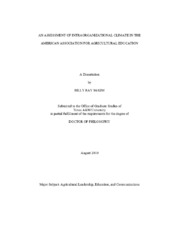| dc.contributor.advisor | Rosser, Manda H. | |
| dc.creator | McKim, Billy Ray | |
| dc.date.accessioned | 2011-10-21T22:03:35Z | |
| dc.date.accessioned | 2011-10-22T07:10:30Z | |
| dc.date.available | 2011-10-21T22:03:35Z | |
| dc.date.available | 2011-10-22T07:10:30Z | |
| dc.date.created | 2010-08 | |
| dc.date.issued | 2011-10-21 | |
| dc.date.submitted | August 2010 | |
| dc.identifier.uri | https://hdl.handle.net/1969.1/ETD-TAMU-2010-08-8556 | |
| dc.description.abstract | Monitoring and evaluation of programs and outcomes is common practice in educational arenas; however, it is not so frequent within professional societies and organizations. By definition, professional organizations are groups of people working together to accomplish a set of goals and objectives that serve the profession. As an organization, the American Association for Agricultural Education (AAAE) serves educators, communicators, and leaders in agriculture through research and application of its principles. A clear understanding of the climate of an organization is important. Understanding the climate of the AAAE could potentially provide AAAE leadership with an understanding of how to improve the functionality of the organization. Organizational climate is a feeling by the members; how they perceive something should be done at that moment.
The research design of this nonexperimental quantitative study was descriptive and inferential in nature. The overarching construct proposed to be measured through conducting this study was organizational climate. A four-section electronic data collection instrument, Organizational Climate Inventory (OCI), was researcher-developed. An ANOVA was used to determine if differences in the OCI scales existed based on selected professional characteristics of AAAE members.
Many individuals pay dues to be members of the AAAE; the return on their investment was not identified in this study. Nearly three-quarters of the membership of the AAAE is held by academic faculty in professorate ranks. Each of the five research priority areas were represented as were each of the three geographic regions. Both the regional and national meetings are relevant and important to the membership.
AAAE members‘ organizational vision was the scale in with the highest mean score; whereas, standard of performance was the scale in which the lowest mean was exhibited. Mean 6σ scores were reported for each of the OCI scales and organized by professional characteristic. Dues-paying-members and non-dues-paying-members did not perceive organizational vision of the AAAE in the same way. Perceptions also differed across all of the scales by region, academic position, and frequency of attendance at regional and national AAAE meetings. | en |
| dc.format.mimetype | application/pdf | |
| dc.language.iso | en_US | |
| dc.subject | Organizational Climate | en |
| dc.subject | Team Climate | en |
| dc.subject | American Association for Agricultural Education | en |
| dc.subject | Intraorganizational Climate | en |
| dc.title | An Assessment of Intraorganizational Climate in the American Association for Agricultural Education | en |
| dc.type | Thesis | en |
| thesis.degree.department | Agricultural Leadership, Education, and Communications | en |
| thesis.degree.discipline | Agricultural Leadership, Education, and Communications | en |
| thesis.degree.grantor | Texas A&M University | en |
| thesis.degree.name | Doctor of Philosophy | en |
| thesis.degree.level | Doctoral | en |
| dc.contributor.committeeMember | Rutherford, Tracy A. | |
| dc.contributor.committeeMember | Murphy, Tim H. | |
| dc.contributor.committeeMember | Tolson, Homer | |
| dc.type.genre | thesis | en |
| dc.type.material | text | en |


